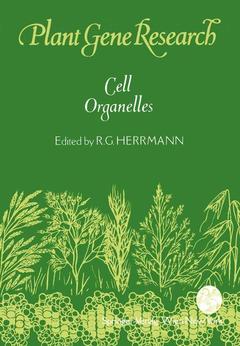Cell Organelles, Softcover reprint of the original 1st ed. 1992 Coll. Plant Gene Research
Langue : Français
Coordonnateur : Herrmann Reinhold G.

The compartmentation of genetic information is a fundamental feature of the eukaryotic cell. The metabolic capacity of a eukaryotic (plant) cell and the steps leading to it are overwhelmingly an endeavour of a joint genetic cooperation between nucleus/cytosol, plastids, and mitochondria. Alter ation of the genetic material in anyone of these compartments or exchange of organelles between species can seriously affect harmoniously balanced growth of an organism. Although the biological significance of this genetic design has been vividly evident since the discovery of non-Mendelian inheritance by Baur and Correns at the beginning of this century, and became indisputable in principle after Renner's work on interspecific nuclear/plastid hybrids (summarized in his classical article in 1934), studies on the genetics of organelles have long suffered from the lack of respectabil ity. Non-Mendelian inheritance was considered a research sideline~ifnot a freak~by most geneticists, which becomes evident when one consults common textbooks. For instance, these have usually impeccable accounts of photosynthetic and respiratory energy conversion in chloroplasts and mitochondria, of metabolism and global circulation of the biological key elements C, N, and S, as well as of the organization, maintenance, and function of nuclear genetic information. In contrast, the heredity and molecular biology of organelles are generally treated as an adjunct, and neither goes as far as to describe the impact of the integrated genetic system.
Section I Organelle Genetics in Lower and Higher Plants.- 1 Organelle Genetics and Transformation of Chlamydomonas.- I. Introduction.- II. Inheritance of Chloroplast and Mitochondrial Genomes.- III. Isolation of Organelle Mutations.- IV. Chloroplast Genes and Mutations Identified in Chlamydomonas.- V. Physical Structure of Organelle Genomes.- VI. Segregation and Recombination of Chloroplast Genes.- VII. Transformation of Chlamydomonas.- VIII. References.- 2 Plastid Genetics in Higher Plants.- I. Three Modes of Plastid Inheritance.- II. Cytological Mechanisms Underlying the Plastid Transmission from the Male Parent.- III. Cytological Mechanisms Influencing the Plastid Transmission from the Female Parent.- IV. Recombination of Plastid Genes in Higher Plants.- V. Plastome Mutations and Their Molecular Basis.- VI. Complex Plastid Characters, Determined by an Interaction of Plastids and Nucleus.- VII. References.- Section II Evolution of Organelle Genomes.- 3 Comparison of Chloroplast and Mitochondrial Genome Evolution in Plants.- I. Introduction.- II. Endosymbiotic Origins of Organelle Genomes.- III. Evolution of Genome Size.- IV. Evolutionary Change in Genome Organization.- V. Sequence Evolution.- VI. Evolution of Organelle Genomes in Algae.- VII. Concluding Remarks.- VIII. References.- Section III Organelle Chromosomes, Genes, and Gene Expression.- 4 Organization and Expression of Genes of Plastid Chromosomes from Non-Angiospermous Land Plants and Green Algae.- I. Introduction.- II. Genome Sizes and Physical Maps.- III. Repeated Sequences and Inversion.- IV. Gene Clusters and Scattered Genes.- V. Plastid DNA Replication.- VI. Plastid Introns and Splicing.- VII. References.- 5 Plastid Chromosomes from Vascular Plants—Genes.- I. Introduction.- II. Chromosome Structure.- III. Genes.- IV. Summary.- V. References.- 6 The Mitochondrial Genome of Plants.- I. The Mitochondrial Genome.- II. Genes.- III. Transcription.- IV. Translation.- V. Conclusion.- VI. References.- 7 Cytoplasmic Male Sterility.- I. Introduction.- II. Maize.- III. Brassica.- IV. Petunia.- V. Vicia faba.- VI. Concluding Remarks.- VII. References.- Section IV Organelle Biogenesis.- 8 Control of Plastid Gene Expression in Chlamydomonas reinhardtii.- I. Introduction.- II. Chloroplast Transformation.- III. Molecular Genetics of Photosystem I (PS 1) and Photosystem II (PS II) Assembly.- IV. Suppression of Chloroplast Mutations in the Gene of the Large Subunit of Ribulose 1, 5 Bisphosphate Carboxylase/Oxygenase (RuBisCo).- V. Chloroplast RNA Accumulation.- VI. Chloroplast RNA Maturation and Splicing.- VII. Chloroplast Translational and Post-translational Events.- VIII. Conclusions.- IX. References.- 9 Biogenesis of Plastids in Higher Plants.- I. Introduction.- II. General Aspects of Chloroplast Biogenesis.- III. Gene Expression.- IV. Compartmental Interaction.- V. Plastid Modifications.- VI. Conclusions.- VII. References.- Section V Protein Import.- 10 Transport of Proteins into Chloroplasts.- I. Introduction.- II. Transit Peptide Structure.- III. Transport Across the Envelope Membranes.- IV. Proteolytic Processing.- V. Intraorganelle Transport and Assembly.- VI. Future Prospects.- VII. References.- 11 Components and Mechanisms in Mitochondrial Protein Import.- I. Introduction.- II. Precursor Proteins and Cytosolic Cofactors.- III. Import Receptors.- IV. Contact Sites.- V. Processing Enzymes.- VI. The Mitochondrial Heat Shock Proteins hsp 60 and hsp 70.- VII. Sorting Pathways.- VIII. Conclusions and Perspectives.- IX. References.- Section VI Glyoxysomes and Peroxisomes.- 12 Structure and Biogenesis of Glyoxysomes and Peroxisomes.- I. Introduction.- II. Historical Survey.- III. General Structure.- IV. The Membrane.- V. Import.- VI. Regulation.- VII. Evolution.- VIII. Summary and Conclusions.- IX. References.
Date de parution : 01-2012
Ouvrage de 467 p.
17x24.4 cm
Disponible chez l'éditeur (délai d'approvisionnement : 15 jours).
Prix indicatif 105,49 €
Ajouter au panierThèmes de Cell Organelles :
Mots-clés :
© 2024 LAVOISIER S.A.S.



